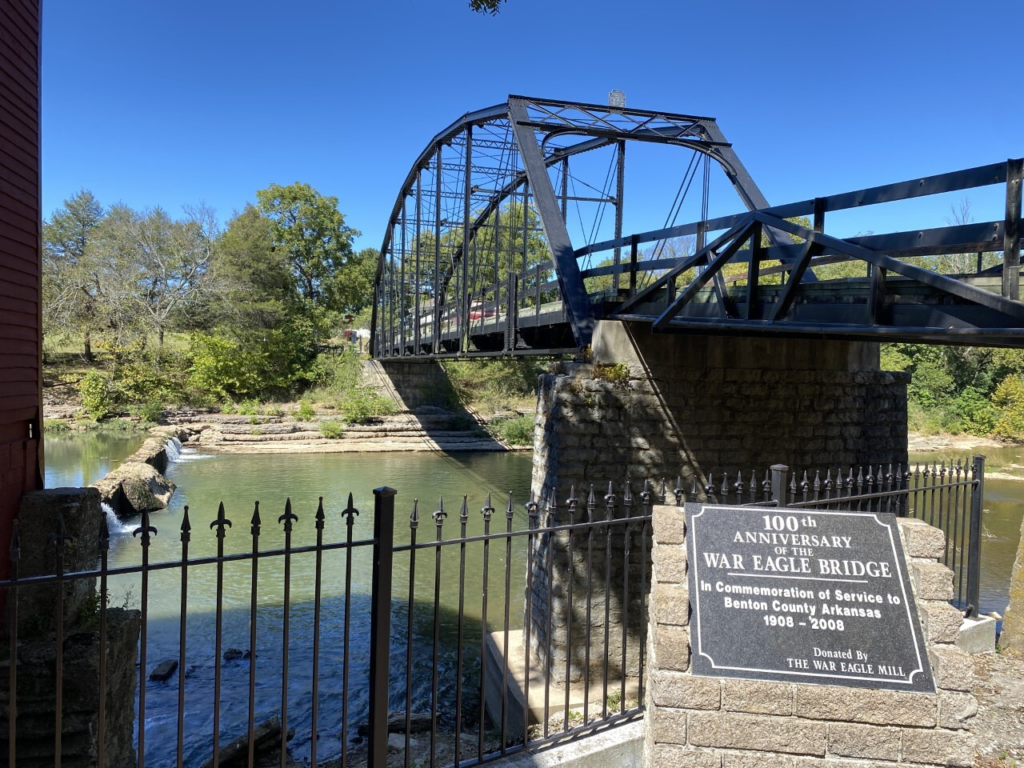Settlement of War Eagle began in 1832 when Sylvanus and Catherine Blackburn established a grist mill along War Eagle Creek. A rural community soon built up around the prospering mill. Today, little remains but the name, the mill and a bridge, yet people still flock to this extremely picturesque spot in Northwest Arkansas.
War Eagle Mill
Between floodwaters, fire and the cost of rebuilding, it’s somewhat amazing that a mill still sits imposingly in this pastoral valley on the bank of War Eagle Creek. The water swallowed the original up in 1848. Confederate soldiers burned the second one to the ground in 1862 to prevent it from being used by the Union. The third mill burned in 1924, cause unknown.
Today’s War Eagle Mill stands as a replica of the 1872 reconstruction that the Blackburn family rebuilt after the Civil War ended.
The mill has continually flooded over the decades, yet caring souls have always made the effort to restore it. Currently, the mill is under the ownership of Elise Roenigk and the leadership of Jack Moyer. They have made recent renovations and changes to preserve it as a historical site and as an iconic tourist destination for the region and the state.
The three-story red mill has been repainted to more closely match what is thought to be the original color, Moyer said. New seating has been set up outside, and access to the creek has been reworked with conservation in mind. Interpretive signage has been added to help people understand the history and importance of the stream running through the area.

The restaurant, formerly on the third floor, has evolved into more of a cafe and bakery now located on the second floor. The menu continues to feature items made with War Eagle Mill products. Stop in for popular dishes such as the club sandwich, beans and cornbread, meatloaf, biscuits and cobbler. Pastries include cinnamon rolls, cupcakes and muffins. There’s a soup of the day and harvest salads. Mountain Bird Coffee from a roastery in nearby Holiday Island is served along with other beverages.
The food is still made in the third floor kitchen. This floor also has overflow tables and chairs for diners when the second floor tables are full. “We use harvest tables so everyone eats together,” Moyer said.
The first floor contains Arkansas-made products and the star of the show, the working water-powered grist mill.
Goods for sale include War Eagle Mill flours and grains, House of Webster jams and jellies and other Arkansas-made products. “Even the crafts are locally made,” Moyer said. Shelves and tables are also filled with aprons, baking tools, coffee mugs, cookbooks, home goods, candles, pottery, gifts, apparel, dog treats, snacks and more.
The Grist Mill
Onlookers outside can see the 18-foot waterwheel with cypress paddles splash when grinding is underway. Inside, the millstones grind grain to a fine meal and the chugging machine spits it into a bucket as Tom Rasmussen, the miller and interpretive guide, explains the grinding process to visitors. He does this daily at 11 a.m. and 1 p.m. in a 20-minute presentation.
“This is how they did it in 1832,” Rasmussen said. “They were pretty ingenious people.”
Rasmussen gives impromptu presentations too if he’s available. He wears a lot of hats. In addition to being the miller, he’s also over maintenance and landscaping. He was trained to mill for interpretive purposes by the former full-time production miller, who retired during the COVID-19 pandemic. Rasmussen said there aren’t many millers left.
“Up until the 1940s, you could probably say there was a grist mill on every river in the nation,” he said.
Currently, the War Eagle Mill is the only watermill in Arkansas and is thought to be the only operational undershot waterwheel in the entire country.
“Most wheels go the other direction,” Moyer said. “That’s what makes it so unique.” Undershot wheels work in running streams and can turn in shallow water.
“The downside to the undershot water mill is you’re going to get floods,” Rasmussen explained. As evidence, one of the beams by the grinding mill is marked with the year and height the water reached inside the mill during historic floods.
Rasmussen also gives history presentations on the third floor to groups that want more in-depth information.
Grinding is now performed for interpretive purposes only, not for food production. A production facility is located a few miles down the road.
War Eagle Bridge
War Eagle Bridge is a one-lane steel bridge built in 1907. It is the only Parker truss bridge in northwest Arkansas, and one of only 17 steel truss bridges in the state. This historic bridge is listed on the National Register of Historic Places.
The bridge spans War Eagle Creek, which flows northwest into Beaver Lake, a manmade reservoir and source of drinking water in Northwest Arkansas.
Cars and pedestrians share the bridge and anglers love fishing beneath it. Folks enjoy wading in the water here as well.

War Eagle Creek
Anglers fish for catfish, bream, perch and bass on this stream, which is also great for floating. Considered a Class 1 or easy-level stream, it’s a particularly good float for families or beginners. It’s generally floatable from March to mid-June, depending on the amount of rain received in the region. One unusual aspect of the creek is that it flows north when other area creeks flow south.
Also on the creek is Withrow Springs State Park, which serves as a put-in point, and an outfitter and shuttle service. The park features campsites, hiking trails, tennis courts, baseball and softball fields, picnic areas and a pavilion.
War Eagle Mill Arts and Crafts Fair
A fall craft show takes place annually on the third weekend of October.
During the fair, the mill offers live entertainment, cafe food favorites and access to hundreds of craft booths. In addition to its own vendors, The Sharps’ Show, another craft fair, takes place on the fields adjacent to the mill while the War Eagle Fair is across the bridge on the War Eagle Farm property. This fall fair, which now includes locations throughout Northwest Arkansas, is often referred to as “War Eagle Weekend,” because it all originated with the War Eagle Fair in 1954.
Expect to find professional craft men and women offering original, handmade work such as watercolor and oil painting, pottery, stoneware, wreaths, dried arrangements, folk art, quilts, wearable art, candles, country decor and clothing, soaps, jewelry, bird houses and feeders, collectibles and more from juried participants.
Getting There
Getting there is half the fun. As soon as you pull off of Arkansas 12 onto County Road 98, a canopy of trees envelopes you for a slow, shady drive. Dappled light hits the curvy road that winds its way down to the mill.
From the other direction, which requires crossing the bridge to get to the mill, there are pockets of tree-shaded lanes and plenty of scenic, rural countryside.
Arkansas Tourism
Arkansas Tourism, a division of the Arkansas Department of Parks, Heritage and Tourism, strives to expand the economic impact of travel and tourism in the state and enhance the quality of life for all Arkansans. The division manages 14 Arkansas Welcome Centers and employs more than 60 staff members across The Natural State. For more information, visit www.arkansas.com.
Arkansas Department of Parks, Heritage and Tourism
The Arkansas Department of Parks, Heritage and Tourism protects and promotes our state’s natural, cultural and historic assets, contributing to a thriving economy and high quality of life. It is made up of three divisions: Arkansas State Parks, Arkansas Heritage and Arkansas Tourism. Stacy Hurst serves as the cabinet secretary for the department.

